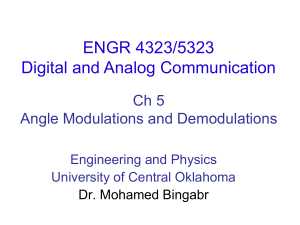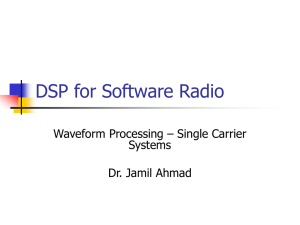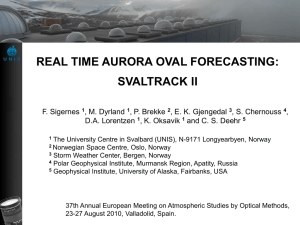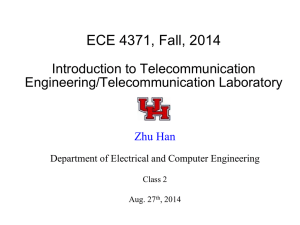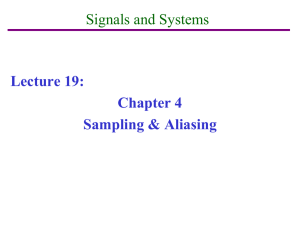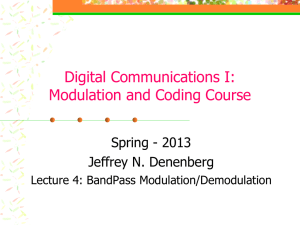ppt
advertisement
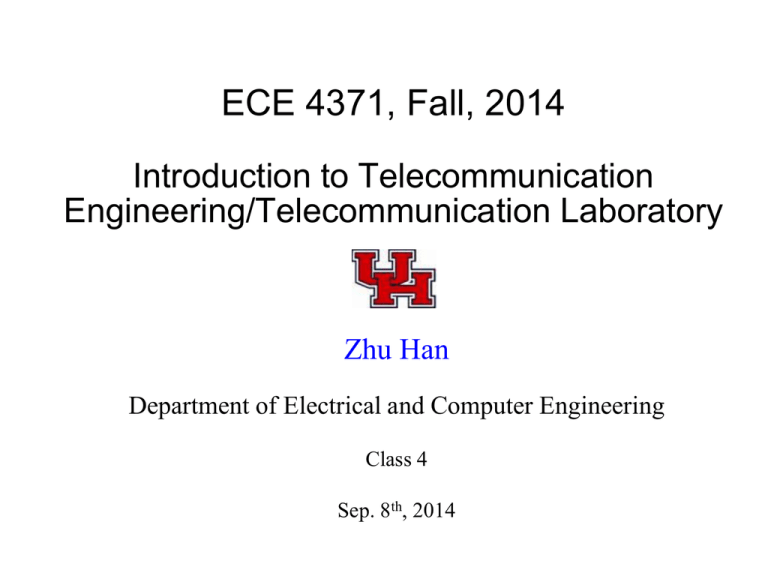
ECE 4371, Fall, 2014
Introduction to Telecommunication
Engineering/Telecommunication Laboratory
Zhu Han
Department of Electrical and Computer Engineering
Class 4
Sep. 8th, 2014
Overview
Homework
– 4.2.1, 4.2.3, 4.2.5, 4.2.7, 4.2.9
– 4.3.3, 4.3.8
– 4.4.2, 4.4.4
– 4.5.2
– 4.8.1
– Due 9/22/14
Phase-locked loop
FM basics
Carrier Recover Error
DSB: e(t)=2m(t)cos(wct)cos((wc+ w)t+)
e(t)=m(t) cos((w)t+)
– Phase error: if fixed, attenuation. If not, shortwave radio
– Frequency error: catastrophic beating effect
SSB, only frequency changes, f<30Hz.
– Donald Duck Effect
Crystal oscillator, atoms oscillator, GPS, …
Pilot: a signal, usually a single frequency, transmitted over a
communications system for supervisory, control, equalization,
continuity, synchronization, or reference purposes.
Phase-Locked Loop
Can be a whole course. The most important part of receiver.
Definition: a closed-loop feedback control system that generates and outputs
a signal in relation to the frequency and phase of an input ("reference") signal
A phase-locked loop circuit responds both to the frequency and phase of the
input signals, automatically raising or lowering the frequency of a controlled
oscillator until it is matched to the reference in both frequency and phase.
Voltage Controlled Oscillator (VCO)
W(t)=wc+ce0(t), where wc is the free-running frequency
Example
Ideal Model
Model
LPF
VCO
– Si=Acos(wct+1(t)), Sv=Avcos(wct+c(t))
– Sp=0.5AAv[sin(2wct+1+c)+sin(1-c)]
– So=0.5AAvsin(1-c)=AAv(1-c)
Capture Range and Lock Range
Carrier Acquisition in DSB-SC
Signal Squaring method
Costas Loop
v1 ( t )
2
1
2
Ac Al m ( t ) cos ,
2
v 2 (t )
1
1
1
v 3 ( t ) Ac Al m ( t ) cos sin Ac Al m ( t )
sin 2
2
2
2
SSB-SC not working
1
2
Ac Al m ( t ) sin
v 4 ( t ) K sin 2
Costas receiver
PLL Applications
Clock recovery: no pilot
Deskewing: circuit design
Clock generation: Direct Digital Synthesis
Spread spectrum:
Jitter Noise Reduction
Clock distribution
FM Basics
VHF (30M-300M) high-fidelity broadcast
Wideband FM, (FM TV), narrow band FM (two-way radio)
1933 FM and angle modulation proposed by Armstrong, but
success by 1949.
Digital: Frequency Shift Key (FSK), Phase Shift Key (BPSK,
QPSK, 8PSK,…)
AM/FM: Transverse wave/Longitudinal wave
Angle Modulation vs. AM
Summarize: properties of amplitude modulation
– Amplitude modulation is linear
just move to new frequency band, spectrum shape does not
change. No new frequencies generated.
– Spectrum: S(f) is a translated version of M(f)
– Bandwidth ≤ 2W
Properties of angle modulation
– They are nonlinear
spectrum shape does change, new frequencies generated.
– S(f) is not just a translated version of M(f)
– Bandwidth is usually much larger than 2W
Angle Modulation Pro/Con Application
Why need angle modulation?
– Better noise reduction
– Improved system fidelity
Disadvantages
– Low bandwidth efficiency
– Complex implementations
Applications
– FM radio broadcast
– TV sound signal
– Two-way mobile radio
– Cellular radio
– Microwave and satellite communications
Instantaneous Frequency
•Angle modulation has two forms
- Frequency modulation (FM): message is represented as the
variation of the instantaneous frequency of a carrier
- Phase modulation (PM): message is represented as the
variation of the instantaneous phase of a carrier
s ( t ) Ac cos i ( t ) ,
w here Ac : carrier am plitude, i ( t ) : angle ( phase)
f i (t )
1 d i (t )
2
s ( t ) Ac cos 2 f c t ( t )
w here ( t ) is a function of m essage signa l m ( t ).
dt
Phase Modulation
PM (phase modulation) signal
s ( t ) Ac cos 2 f c t k p m ( t )
( t ) k p m ( t ),
k p : phase sensitivity
instantanous frequency f i ( t ) f c
k p dm ( t )
2
dt
Frequency Modulation
FM (frequency modulation) signal
s ( t ) Ac cos 2 f c t 2 k f
m
(
)
d
0
t
k f : freq u en cy sen sitivity
in stan tan o u s freq u en cy f i ( t ) f c k f m ( t )
an g le i ( t ) 2
t
0
f i ( ) d
2 f c t 2 k f
(Assume zero initial phase)
t
0
m ( ) d
FM Characteristics
Characteristics of FM signals
– Zero-crossings are not regular
– Envelope is constant
– FM and PM signals are similar
Relations between FM and PM
FM o f m ( t )
P M of m ( t )
PM of
FM of
t
m ( ) d
0
dm ( t )
dt
FM/PM Example (Time)
FM/PM Example (Frequency)
Matlab
fc=1000; Ac=1; % carrier frequency (Hz) and magnitude
fm=250; Am=0.1; % message frequency (Hz) and magnitude
k=4;
% modulation parameter
% generage single tone message signal
t=0:1/10000:0.02;
% time with sampling at 10KHz
mt=Am*cos(2*pi*fm*t); % message signal
% Phase modulation
sp=Ac*cos(2*pi*fc*t+2*pi*k*mt);
% Frequency modulation
dmt=Am*sin(2*pi*fm*t);
% integration
sf=Ac*cos(2*pi*fc*t+2*pi*k*dmt); % PM
% Plot the signal
subplot(311), plot(t,mt,'b'), grid, title('message m(t)')
subplot(312), plot(t,sf,'r'), grid, ylabel('FM s(t)')
subplot(313), plot(t,sp,'m'), grid, ylabel('PM s(t)')
Matlab
% spectrum
w=((0:length(t)-1)/length(t)-0.5)*10000;
Pm=abs(fftshift(fft(mt))); % spectrum of message
Pp=abs(fftshift(fft(sp))); % spectrum of PM signal
Pf=abs(fftshift(fft(sf))); % spectrum of FM signal
% plot the spectrums
figure(2)
subplot(311), plot(w,Pm,'b'),
axis([-3000 3000 min(Pm) max(Pm)]), grid, title('message spectrum M(f)'),
subplot(312), plot(w,Pf,'r'),
axis([-3000 3000 min(Pf) max(Pf)]), grid, ylabel('FM S(f)')
subplot(313), plot(w,Pp,'m'),
axis([-3000 3000 min(Pp) max(Pp)]), grid, ylabel('PM S(f)')
Frequency Modulation
FM (frequency modulation) signal
s ( t ) Ac cos 2 f c t 2 k f
m
(
)
d
0
t
k f : freq u en cy sen sitivity
in stan tan o u s freq u en cy f i ( t ) f c k f m ( t )
an g le i ( t ) 2
t
0
f i ( ) d
2 f c t 2 k f
m ( t ) Am cos(2 f m t )
(Assume zero initial phase)
t
m ( ) d
0
f i f c k f Am cos(2 f m t )
d 2 k f
1 d
1 d 2 f c t
1
fi
2 dt
2
dt
2
fc
1
2
2 k f Am cos(2 f m )
Let t
t
0
Am cos(2 f m ) d
dt
Example
Consider m(t)- a square wave- as shown. The FM wave for this m(t) is
t
shown below.
FM ( t ) A cos( c t k f
m( )d ).
-
t
Assume m(t) starts at t 0. For 0 t T
m(t) 1 ,
2
m( )d t
and
0
t
for
T
2
t T
m(t) - 1
,
ous frequency
t
2
m( )d m( )d m( )d
0
The instantane
T
T
2
- (t - T ) T - t.
2
T
0
2
is i ( t ) c k f m ( t ) c k f
for
and i ( t ) c k f for T t T .
2
i max c k f
and
i min c k f
m(t)
0
T
2T
t
FM ( t )
t
0 t T
2
Frequency Deviation
Frequency deviation Δf
– difference between the maximum instantaneous and carrier frequency
f k f Am k f m ax | m ( t ) |
– Definition:
– Relationship with instantaneous frequency
single-tone m ( t ) case: f i f c f cos(2 f m t )
general case:
fc f fi fc f
– Question: Is bandwidth of s(t) just 2Δf?
No, instantaneous frequency is not
equivalent to spectrum frequency
(with non-zero power)!
S(t) has ∞ spectrum frequency
(with non-zero power).
Modulation Index
Indicate by how much the modulated variable (instantaneous
frequency) varies around its unmodulated level (message
frequency)
A M (envelope):
m ax | k a m ( t ) |
,
1
A
FM (frequency):
m ax | k f m ( t ) |
fm
Bandwidth
a (t )
t
m ( ) d
2
2
kf 2
kf 3
( t ) Re( ( t )) A cos w c t k f a ( t ) sin w c t
a ( t ) cos w c t
a ( t ) sin w c t ...
2!
3!
Narrow Band Angle Modulation
Definition
k f a ( t ) 1
Equation ( t ) A cos w c t k f a ( t ) sin w c t
Comparison with AM
Only phase difference of Pi/2
Frequency: similar
Time: AM: frequency constant
FM: amplitude constant
Conclusion: NBFM signal is
similar to AM signal
NBFM has also bandwidth
2W. (twice message signal
bandwidth)
Example
Block diagram of a method for generating a narrowband FM
signal.
A phasor comparison of narrowband FM and AM waves for
sinusoidal modulation. (a) Narrowband FM wave. (b) AM wave.
Wide Band FM
Wideband FM signal
m ( t ) Am cos(2 f m t )
s ( t ) Ac cos 2 f c t sin(2 f m t )
Fourier series representation
s ( t ) Ac
J n ( ) cos 2 ( f c nf m ) t
n
S( f )
Ac
2
J n ( ) ( f f c nf m ) ( f f c nf m )
n
J n ( ) : n -th order Bessel function of the firs t kind
Example
Bessel Function of First Kind
1 . J n ( ) ( 1) J n ( )
n
2 . If is sm all, th en J 0 ( ) 1,
J1( )
Jn( ) 0
3.
n
J n ( ) 1
2
,
2
fo r all n 2
Spectrum of WBFM (Chapter 5.2)
Spectrum when m(t) is single-tone
s ( t ) Ac cos 2 f c t sin(2 f m t ) Ac
J n ( ) cos 2 ( f c nf m ) t
n
S( f )
Ac
2
n
Example 2.2
J n ( ) ( f f c nf m ) ( f f c nf m )
Spectrum Properties
1. frequencies: f c , f c f m , f c 2 f m ,
(for all n ).
, f c nf m ,
T heoretically infinite bandw idth.
2. For << 1 (N BFM ), frequency: f c , f c f m
J 0 ( ) 1, J 1 ( ) J 1 ( ), J n ( ) 0 for all n 2
3. M agnitude of f c nf m :
Ac
2
J n ( ), depend on
4. C arrier ( f c ) magnitude J 0 ( ) can be 0 for some
5. A verage pow er: P
n
A
2
c
1
2
J ( )
2
n
1
2
2
Ac
Bandwidth of FM
Facts
– FM has side frequencies extending to infinite frequency
theoretically infinite bandwidth
– But side frequencies become negligibly small beyond a point
practically finite bandwidth
– FM signal bandwidth equals the required transmission
(channel) bandwidth
Bandwidth of FM signal is approximately by
– Carson’s Rule (which gives lower-bound)
Carson’s Rule
Nearly all power lies within a bandwidth of
– For single-tone message signal with frequency fm
BT 2 f 2 f m 2( 1) f m
– For general message signal m(t) with bandwidth (or highest
frequency) W
BT 2 f 2W 2( D 1)W
w h ere D
f
is d eviatio n ratio (eq u ivalen t to ),
W
f m ax k f m ( t )
